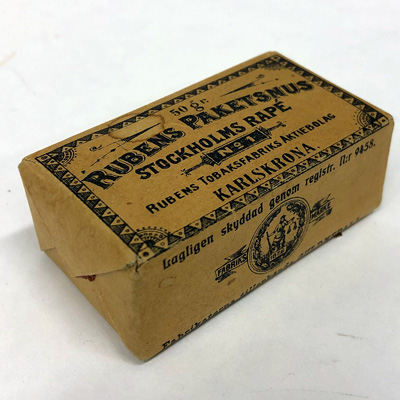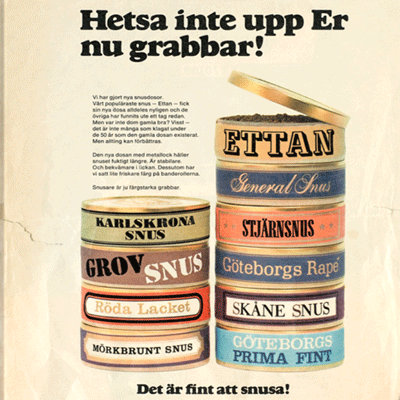In 1492, Columbus made landfall in the New World, in the region of the Bahamas. New cultures with new goods, seeds, and habits would change Europe forever.
In the 'New World', the ship's crew were met by the native population, the Lucayans, and were handed gifts - including "some dry leaves that they regarded as valuable", as Columbus wrote in his diary. The sailors saw how the natives rolled the dry leaves with a maize leaf, set fire to the roll, and inhaled the smoke. The roll was called a "tobago". The Spanish and Portuguese brought the tobacco plant back across the Atlantic to Europe. Later on, the French ambassador Jean Nicot placed in Lisbon, would play an important role in the plant's spread across Europe. For this, Carl Von Linné would base its Latin name after Jean Nicot - Nicotiana.
It is said that the French queen, Catherine de' Medici (1519-1589), suffered from severe headaches and that on the advice of Jean Nicot. The queen tried nasal snus - finely ground dried tobacco leaves. Her headaches got better, and Catherine continued using snuff, which led to nasal snuff becoming popular at the French court.
Tobacco usage then spread rapidly throughout Europe and reached Sweden at the end of the 1500s. The earliest mention of tobacco in Sweden dates from 1601 when the Customs Office in Stockholm noted the importation of tobacco and pipes into the country.
Snuff usage was very popular in aristocratic circles in the 1700s, but it was quite different from today's "snus". Snuff in the 1700s was a dry, finely ground, and aromatic tobacco powder that was consumed nasally.
Snuff was a luxury product, and its manufacture was expensive. As a result, its users - both male and female - were mainly members of the upper class. But by 1789, the French Revolution changed everything and marked the beginning of the end for the strict class society that had been regarded as an expression of a universal, natural law. With this change, the use of snuff came to an end for the upper class, instead the working class started to use both snuff and Swedish snus.
While smoking or chewing tobacco took the place of snus, oral snus - or wet snus - increased in popularity in the early 1800s in Sweden. Wet snus was made by combining dried tobacco leaves with water, salt, and potash - and of course, different ingredients for taste. Bergamot, juniper berry, and different flowers were usual ingredients for adding other tastes to the snus.
We do not know exactly when the wet snus emerged, but we do believe it was the farmers who developed it - and they did so all across the country, making their own by using tobacco they grew in their own yards. Tobacco farming was not uncommon in Sweden; rather, it was very common.
In the beginning of the 1700s, the Swedish King Fredrik I, who was inspired by mercantilistic ideals, ordered every town in Sweden to start growing tobacco. Rather than importing, he wanted to start exporting, and as tobacco was one of those products that Sweden was importing large amounts of, it resulted in this decree.
Tobacco cultivation in Sweden was a female occupation, and farms and knowledge were handed down mother to daughter. The tobacco plant can only grow during the summer, and during this season young women would come from small towns to work on tobacco plantations.
The use of snus was enhanced by the industrial revolution and people moving into the cities. Working on fields, and deciding over one's own breaks, as well as being able to grow tobacco in one's own yard, meant that you could take a break whenever you felt like it to indulge in smoking or chewing tobacco. But when working in the cities and in factories, it meant that you had more restricted working conditions. However, the snus you could easily put under your lip and enjoy for a longer time, making it a perfect indulgence for 'the modern man'.
Buying snus was also rather cheap, and was bought in various different types of paper packaging, such as a box or a cartridge, and then transferred to the individual's own snus box. The common man usually made his own box from simple materials but put a great deal of effort into the execution, making it as luxurious as possible. When two met and introduced themselves, or simply greeted one another, it was common to extend one's snus box and offer a pinch of snus. The Swedish word for a 'pinch' - 'pris' - came from the French and meant 'token'. Commonly inscripted on Snus boxes was "Tag en pris" - which translates to; "Take a pinch".
By 1897, there were 97 tobacco factories with over 4000 workers in Sweden. However, there were a few brands and companies that were at the top: Jacob Fredrik Junglöf with Ettan ('number 1'), Johan Adolf Boman with General, the brothers Petter and Olof Swartz with Röda Lacke ('the red laquer'), and W:m Hellgren & Co with Grofsnus ('rough snus').
In 1915, all of their, and all other snus manufacturers' stories would end, as the state implemented a monopoly on snus-making. The state needed money to fund the army and to provide pensions to the workers. Thus, the state acquired all tobacco manufacturers and all brands - as snus manufacturing still was one of the most lucrative businesses in Sweden. From the over 100 snus brands existing on the market, only about 20 were kept in production. It would take another four decades until the monopoly on tobacco making would cease to exist.
In the 1920s snus consumption began to decline, and reached its lows in the 1950s. In the 1960s health reports about the hazard of smoking in combination with a "new launch" of snus resulted in an increase in snus consumption in 1969.
The Swedish tradition of using snus might have been a thing of the past if it had not been for the invention of the "portionssnus" (portioned snus).
The first portioned snus to be launched in Sweden was the product "Smokeless" in 1973, in an effort to make smokers quit. The product wasfollowed by the product "Tre Ankare" (three ankers) in 1977, and after that the portioned snus had become a staple in Swedish snus tradition. It is today the most sold snus type of all.
During 1979, the demand for snus surpassed production levels, resulting in several instances of sold-out stock. Consequently, the state-owned Svenska Tobaks AB inaugurated a new snus factory in Gothenburg in 1983 to address the supply shortage.
In 1993, when Sweden sought to join the European Union, a significant challenge arose for the snus tradition due to the EU's ban on snus in 1992. However, owing to Sweden's extensive historical legacy with snus, an exception was granted, allowing for the sale and consumption of snus within the country.







